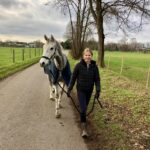In recent years, the keeping of horses has also changed. Technical progress is also visible here and brings progress in the area of animal welfare.
The Wolfsgrund horse farm in the district of Rotenburg in Lower Saxony (Germany) is a positive example. The horse farm is an active stable where the horses have a lot of contact with other horses.
One of the technical innovations is an automatic feed rack. When the horse steps into the feed rack, a slide opens in the front area and access to the hay is free. It also works the same way with concentrated feed. A chip in the horse’s mane recognises how much and which feed the animal receives.
There are about 25 horses in a herd. There are halls with straw to lie on, areas with sand and stone floors and access to pasture.
A horse farm, not a riding stable
This is how Volker Peatzold, the farm’s operator, puts it. He says: “The horse should feel good, then the human being feels good, too”. A total of 24 hectares belong to the farm. Around 50 private horses are accommodated. In addition to the active stable, pastures and exercise areas, there is a riding hall, a riding arena, a lunging circle and 20 paddock boxes. Paddock boxes are horse boxes with a small, fenced-in outdoor area. Horses that are kept there go out to pasture every day. Movement, light, variety and contact with other horses are very important in horse keeping from the operator’s point of view.
He is not the only one with this view; many other horse farm operators have also changed their attitude. In the meantime, you can no longer recognise a horse farm by the horse trailers standing in front of the door, but by the horses standing outside on the pastures. The amount of movement that stables offer is now also a search criterion for horse owners when choosing a stable.
Are open stables and active stables better?
In an active stable, the areas for exercise, eating and resting are separated from each other, the horses should move a lot. In an open stable, the horses are also kept in a group. In this type of housing, the animals also have permanent access to an outdoor area.
According to experts, however, an open or active stable is not automatically better than keeping horses in boxes. Often, too many horses are housed in too small an area. They can go in and out, but have no space to trot and gallop. Box stabling, where the horses get daily outdoor, can therefore be more species-appropriate than keeping them in a small open stable. Stables in which horses do not have access to open air in winter will soon be a thing of the past.
Animal welfare first
Animal welfare should always come first. And yet there are many horse farms that do not keep their horses in a species-appropriate manner. However, open stables and stalls for exercise are playing an increasingly important role. There is a clear trend towards more space, air, freedom of movement and exercise. Hof Inhaber Paetzold, who exchanges ideas with horse owners and farms, also sees a development. “It’s going much too slowly for me, but it’s going in the right direction,” says the 59-year-old. Horse farms like his are still in the minority, he says. “But: more are coming.”
The Federal Ministry of Agriculture in Berlin refers to the Animal Welfare Act. According to it, animals must be housed in a manner appropriate to their behaviour. The “Guidelines for the assessment of horse keeping under animal welfare aspects”, which the ministry published in 2009, states, among other things: “All horses, but especially broodmares, foals and young horses, must be offered pasture and/or outdoor access as often as possible.” This contributes to the health and welfare of the animals.
Source: Berchtesgadener Zeitung

